National Memorial for the Mountains

Kayford Mountain, WV
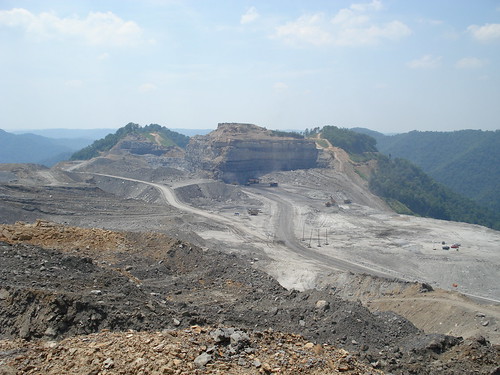
August 15, 2007
A True Hero: 22 years and going strong!
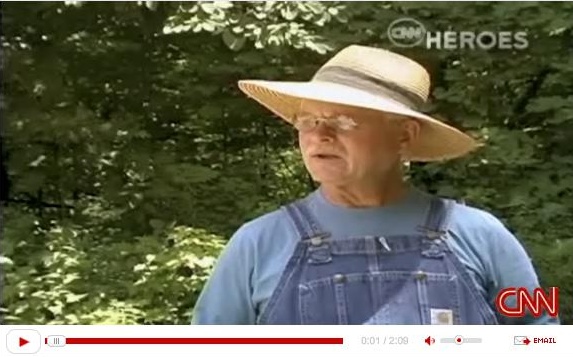 CNN Heroes debuted the story “Larry Gibson: Defending the Planet” on Tuesday, 8/14, during Anderson Cooper 360. It will also be aired this Thurs 8/16 and Sun 8/19 all day ON CNN & CNN HEADLINE NEWS. (2 separate channels). An extended version will be available on the CNN Hero’s website next week.
CNN Heroes debuted the story “Larry Gibson: Defending the Planet” on Tuesday, 8/14, during Anderson Cooper 360. It will also be aired this Thurs 8/16 and Sun 8/19 all day ON CNN & CNN HEADLINE NEWS. (2 separate channels). An extended version will be available on the CNN Hero’s website next week.
For more than 200 years, Larry Gibson’s ancestors have lived on Kayford Mountain in the Appalachians of West Virginia. Today, he is fighting to protect his coal-rich land from mountaintop blasting and the consequences he fears it would have for the environment.
Donate to the Keeper of the Mountains Foundation by visiting www.mountainkeeper.org
8 Comments » Leave your own...
Over 100 gathered to pray for an end to devastation from mountaintop removal mining
CABIN CREEK, W.VA. — Over 100 people of all ages and faiths gathered on Kayford Mountain Saturday (Oct. 20) at a prayer vigil for the mountains and people of Appalachia affected by mountaintop removal mining. Religious leaders representing a range of denominations and backgrounds led prayers and hymns honoring the state’s mountains and asking for the healing of people harmed by surface mining.
The vigil, hosted by the Ohio Valley Environmental Coalition, a West Virginia group fighting mountaintop removal, brought together families, college students and faith-based groups from across the state and region with attendees from as far as Michigan and South Carolina. The gathering came on the heels of last week’s Council of Churches statement condemning mountaintop removal as “unprecedented and permanent.”
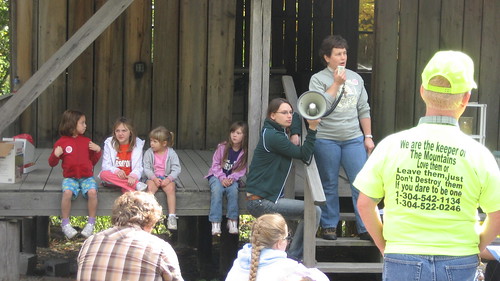
“We organized this event to help connect religious communities in the region and hope it will compel people of faith to tell the story of what mountaintop removal is doing to our people,” said Rev. Robin Blakeman, a Presbyterian minister and OVEC volunteer who organized the event.
Throughout the vigil, people directly impacted by this extreme form of mining shared their experiences, including Pauline Canterberry of Sylvester, one of the famed “Sylvester DustBusters.” She explained how coal dust covers the inside of Sylvester residents’ homes, clogging indoor air filters and in some cases causing black lung disease in people who have never entered a mine.
Brenda McCoy of Mingo County held up jars of dark red and black water from people’s homes in her community and explained how their water was poisoned by the underground injection of coal sludge, a waste product from coal preparation plants. People in Mingo County just recently won access to city water from the state after their water was declared toxic. Other communities with similar water issues are also facing unusually high levels of cancer and organ trouble, according to OVEC.
“I think we are looking for a transformation of the heart, to care and weep for God’s creation, and become instruments of healing for the earth and justice for people,” said Allen Johnson, coordinator of Christians for the Mountains, an organization working to rally Christians for solutions to mountaintop removal.

After prayers led by Presbyterian, Unitarian, Episcopal and United Methodist pastors, and testimonies from directly impacted residents from all over southern West Virginia, the group walked to a spot on Kayford Mountain from which they could overlook part of the 12,000 acres of mountaintop removal operations that are consuming the mountain.
“I was blown away that something like this could happen in the United States. It looked like a scar on the land, like a huge bomb had been dropped in the mountains,” said Briana McElfish, a Marshall University student from Putnam County. “We have to look for different ways to get energy. Our country’s coal dependence affects us the most, so we, more than anyone else, should be looking at alternatives. We should be leading the way in renewable energy and efficient technologies, creating jobs and protecting our people.”
“So many children and families are harmed by mountaintop removal in this state. I hope the faith community gets more organized and aware and acts from a deep theological place making this one of the primary moral and ethical concerns for people of faith in our area,” said Blakeman.
In mountaintop removal, coal companies raze forests, then use explosives and giant machines to scalp hundreds of feet off the tops of mountains, in order to get to thin seams of coal. Central Appalachia’s forests are some of the most biologically diverse temperate forests on earth, and studies show mountaintops-removal-mined forests may not recover for centuries.
Hundreds of millions of tons of rubble from the blasted mountaintops is pushed into nearby valleys, burying streams and creating valley fills. In West Virginia, over 1,200 miles of biologically crucial headwaters streams have already been buried or impacted by valley fills.
Concerned citizens say mountaintop removal not only destroys water and forests, but that it also erodes mountain culture. Some people are driven away, and those who do stay see their property devalued and their water wells ruined. The noise and silica-laden dust from blasting at the mine sites adversely impacts people’s health. Studies have shown that valley fills mountaintop removal exacerbates flooding during storm events.
—
Photos by Liz Veazey. See more photos here
No comments yet » Leave your own...
On April 18, Ohio Valley Environmental Coalition board member Larry Gibson and OVEC organizer Abe Mwaura met with Lois Armstrong, a longtime resident of Cabin Creek. Lois, along with others in the community of Coalville, organized to stop the construction of a coal loading dock, which would have been illegally close to folks’ homes in the area.
The following is part of the rich conversation that took place when Larry and Lois met. It begins abruptly when Abe realized that he should probably be recording the conversation – with their permission, of course:
Larry: It’s got to be a human rights story, linked to mountaintop removal.

Lois: But you don’t have any rights.
Larry: That’s it. That’s the whole point…
Lois: We don’t have any rights.
Larry: And you and I both remember the time… if somebody in our area worked for a non-union outfit, they wouldn’t tell anybody back then. Now, if a man works for a union, he doesn’t tell anybody.
Lois: He’s afraid of being ostracized too.
Larry: Sure. I don’t have the wisdom of time like you have. So I’m looking to you to kind of guide me and my friend here. What we’re trying to do is really trying to save some lives. We’re not trying to punish the workers. If they had the choice, they wouldn’t be destroying their own back yard…
I can’t back up from this. When I was a kid people used to tell me I was crazy. But I still gotta stay with this. This is not a jobs issue. This is not simply an energy issue. It’s a human rights issue. You know that it is. Until we can strike a nerve in people, whatever the discomfort is in their lives at this point will still be there in the future.
 Abe: How do we do that?
Abe: How do we do that?
Lois: I don’t know.
Abe: How did they do it in the past?
Lois: [pause] I don’t think people used to be as intimidated as they are now.
Larry: No they weren’t.
Abe: Hmm. What’s changed?
Lois: [very deliberately] The feeling of powerlessness.
Abe: You think it’s more now than it used to be?
Lois: Oh yes.
Abe: Well what’s caused that? Why now, and compared to when? Ten years ago, 20 years ago?
Lois: Compared to when I was a kid. Yes. My grandfather was a very strong man. Very quiet – but very powerful. He didn’t shout or make a big noise. What he did, he did very quietly. And he would talk to different people there in Chelyan, when people would come in and try to change things. And he would do it one on one – you know go in and talk to the old-timers. But, I think people now feel hopeless. They feel overwhelmed with the power that others have – that they don’t feel they have.
Abe: And now I’m trying to figure out what is it that caused that. What changed in that amount of time that made them feel so powerless, so that we can figure out what it would take to make them feel powerful again. And it’s not just feel… really, we all have some sense of power – sometimes we just don’t use it. What is it that changed? They’ve lost their power – but why?
Larry: Could it be that the fact that the different leaders of not only the government, but even the union itself…
Lois: Even the courts…
Larry: …even the courts have caved in to the industries. That’s my opinion. That they have caved in to the industries. The people that you and I count on to oversee our rights are the ones who’ve given up our rights – as far as fighting for us.
Lois: But not only on the local level, but the state level, the national level – the whole thing.
Larry: Right. But it starts here. We have more power than we realize because we all have a voice – if we can get it together, and start getting people back together again, and start focusing on what they’ve lost. If we can do that, we can encourage them to take another look at themselves. Otherwise, like I said the miseries that they have now will only get worse.
Abe: And your father did that one on one?
Lois: My grandfather. Ya. Chelyan is still unincorporated, and it was those old timers who decided that they did not want to be incorporated. He was one of those old timers and he would say “if you give them a little bit of power they’ll take it all. As long as you don’t give them any power, they can’t take it.”
Larry: Hmm. Well that’s the whole point. That’s what we’re saying. It’s time, with whatever power we’ve got left… we have to organize and direct it in a positive direction instead of letting it sit dormant. We can have all the power we’ve got now, and if its not being used, then what’s the use of having it… We used to have some choice in the direction we were going in, and now they’ve taken that away.
When I went to New York last week I called for the rebirth of resistance, and I never thought I’d hear such a roar of people saying “Yeah, we need the rebirth of resistance.” Well yeah, we need a rebirth of resistance here to get back what the people have lost!
Abe: What does that mean? What does it look like?
Larry: Well right now there is not enough resistance. You know that…
We are natural organizers. We live in the area called the coalfields – where the union was strong. If we hadn’t organized in the beginning we would never have had anything.
We can’t back up… We gotta get that grit back. That’s what we’ve got to find in people today. They’ve got it; they’ve just forgotten that they have it.
To support and learn more about communities organizing in Cabin Creek and around Kayford Mountain go to www.ohvec.org
No comments yet » Leave your own...
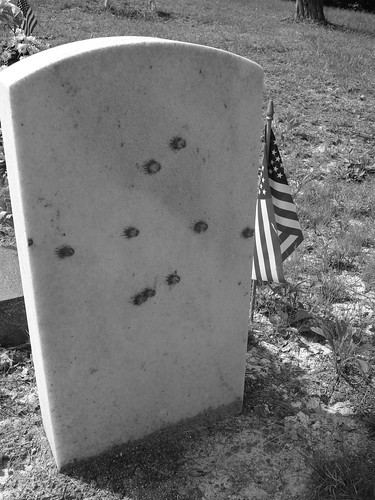 These entries are based on research or interviews conducted by Appalachian Voices staff and volunteers- we’d love for you to add another story or eulogy, and let us know if you’d like to request a change.
These entries are based on research or interviews conducted by Appalachian Voices staff and volunteers- we’d love for you to add another story or eulogy, and let us know if you’d like to request a change.
Kayford Mountain and its surrounding areas have been the home of Larry Gibson’s family since the 1700’s. More than three hundred of his relatives are buried in the family cemetery there, and when he grew up on Kayford’s beautiful slopes, the mountains rose in every direction from his house. He treasures some of the best memories of his life from those days. He recalls that “it wasn’t the fast life then, it was the good life.”
In 1986, the mountaintop removal started. Over the next 20 years, “the slow motion destruction of Kayford Mountain has been continuous – 24 hours a day, seven days a week.” Arch Coal Inc., Horizon Natural Resources and Massey Energy have flattened the mountains surrounding Larry’s house into a 12,000 acre “pancake.” The mine comes to within 200 feet of the family cemetery, and the blasts make the ground shake. Stray rocks from the explosions land near the gravestones and scar the ground. As one visitor noted, “gone is the peace and stillness that the old cemetery once harbored. For Gibson and other family members, mountaintop mining is practically raising the dead, while burying the living.”
4 Comments » Leave your own...
Share Your Photos and Stories About this Mountain
If you have stories, photos, audio, or video of the mountains or communities near this mountain, please email us.
 CNN Heroes debuted the story “Larry Gibson: Defending the Planet” on Tuesday, 8/14, during Anderson Cooper 360. It will also be aired this Thurs 8/16 and Sun 8/19 all day ON CNN & CNN HEADLINE NEWS. (2 separate channels). An extended version will be available on the CNN Hero’s website next week.
CNN Heroes debuted the story “Larry Gibson: Defending the Planet” on Tuesday, 8/14, during Anderson Cooper 360. It will also be aired this Thurs 8/16 and Sun 8/19 all day ON CNN & CNN HEADLINE NEWS. (2 separate channels). An extended version will be available on the CNN Hero’s website next week.




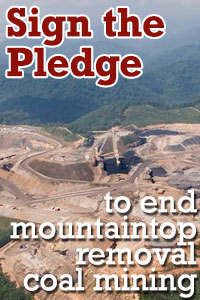









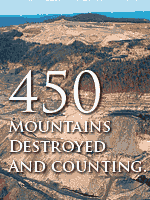



 Abe: How do we do that?
Abe: How do we do that?
 These entries are based on research or interviews conducted by Appalachian Voices staff and volunteers- we’d love for you to add another story or eulogy, and let us know if you’d like to request a change.
These entries are based on research or interviews conducted by Appalachian Voices staff and volunteers- we’d love for you to add another story or eulogy, and let us know if you’d like to request a change.
